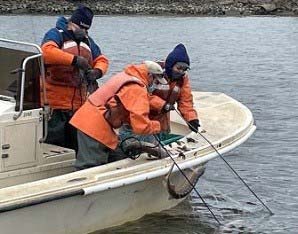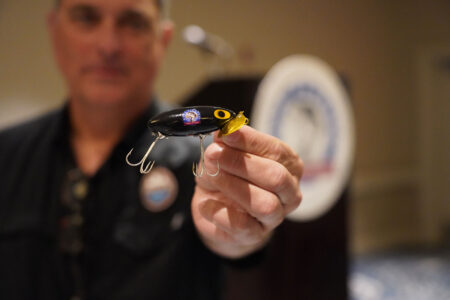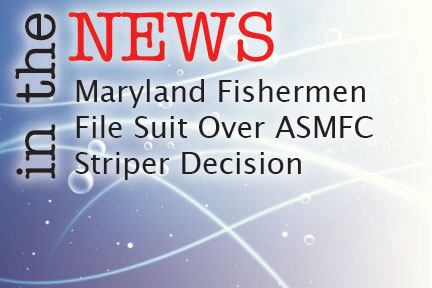 Shortnose sturgeon (Acipenser brevirostrum) is the smallest of New York’s sturgeons, rarely exceeding 4 feet in length and 18 pounds in weight. Adult shortnose sturgeon migrate upriver from their mid-Hudson overwintering areas to freshwater spawning sites north of Coxsackie, but much of their spawning behavior and early life-stages are still not fully understood.
Shortnose sturgeon (Acipenser brevirostrum) is the smallest of New York’s sturgeons, rarely exceeding 4 feet in length and 18 pounds in weight. Adult shortnose sturgeon migrate upriver from their mid-Hudson overwintering areas to freshwater spawning sites north of Coxsackie, but much of their spawning behavior and early life-stages are still not fully understood.
Shortnose sturgeon was the first fish listed as endangered with enactment of the 1973 Endangered Species Act. Soon after, researchers conducted a population estimate for Hudson River shortnose sturgeon in order to develop recommendations for managing the recovery of this fish. A second population study in the 1990s indicated a substantial increase in the spawning population from the 1970s.
The shortnose sturgeon population in the Hudson River may now be the largest in the world. However, this assessment is based on research that is several decades old, and new studies are needed to support management and recovery actions.
Newer technologies now available, such as high resolution side-scan sonar and acoustic telemetry, have been successfully used to provide enhanced population estimates for other sturgeons. Acoustic telemetry uses receivers to detect signals emitted from tagged marine species like sturgeon. The side-scan sonar uses sound to create an image of the river floor and objects in the water column, and is one method for counting fish. Smaller objects in the river, such as shortnose sturgeon, are harder to distinguish.
In 2018, staff from DEC’s Hudson and Delaware Fisheries Unit worked with scientists from the universities of Delaware and Delaware State to test whether side-scan sonar could be used to assess the river’s population of shortnose sturgeon. Fisheries staff built wooden sturgeon of different sizes and mounted them to cement blocks. The models were lowered to the bottom of the river in random order. The side-scan sonar was then pulled through the area imaging the models. The sonar was able to detect these smaller-sized shortnose sturgeon models.
This spring, academic, federal, and state research scientists embarked on a large-scale project that will provide an updated estimate for the Hudson’s shortnose sturgeon population using acoustic telemetry and side-scan sonar. In April and May, 50 adult shortnose sturgeon were netted on the spawning grounds north of Coxsackie and surgically implanted with long-lived (10-year) acoustic transmitters. These transmitters will be detected on a river-wide array of acoustic receivers as the fish move throughout the Hudson River estuary. The receivers will store the unique tag number and the date and time that a fish swims past a receiver (like E-Z Pass for sturgeon).
In the winter, fisheries staff will use side-scan sonar to image and count individual shortnose sturgeon in overwintering areas. These estimates will be mathematically merged with the river-wide telemetry data to estimate the proportion of individual fish in the overwintering areas, and by extension, in the overall Hudson River. This provides a robust and relatively low-cost means to track recovery of America’s first endangered fish.
Funding for this project comes from the Hudson River Foundation and the Hudson River Estuary Program. The shortnose sturgeon were collected and tagged under a National Marine Fisheries Service Endangered Species Act Research permit # 20340.




